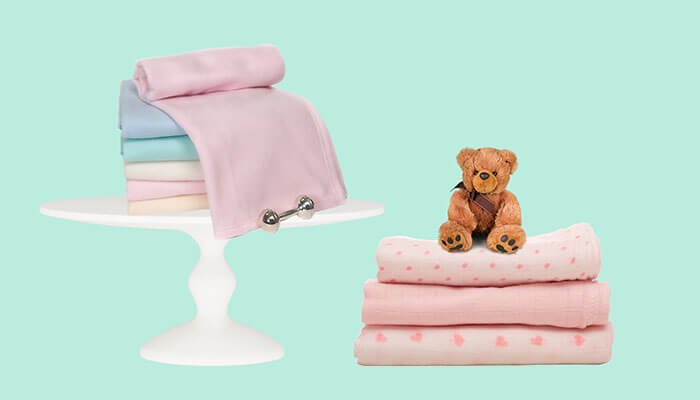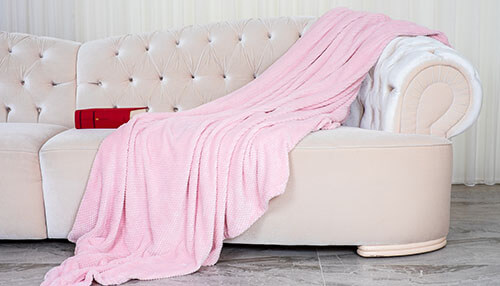Muslin blankets are made from loosely-woven cotton fabrics. It is made by utilizing the plain weave technique. This technique makes use of a single weft thread alternating over and under a single warp thread. Muslin blankets are typically used in fashion prototypes for pattern testing before they are cut and stitched into a final product. Muslin blankets are made from lightweight and breathable muslin fibers. This material finds its roots back in Ancient India.
Muslin was named after the city where it originated and is a woven cotton fabric in essence. Mosul is the city capital of the Nineveh Governorate in what is now pointed to be northwestern Iraq. Muslin became a fabric for as long as Marco Polo existed in the late-1200s.
There is also another popular fine Indian muslin, the Dhaka muslin, amongst royalty. This kind of muslin – not commonly used for modern muslin blankets – came from initially woven fine yarns from a specific cotton plant, the phuti cotton. A thriving muslin trade then was established by a consultant for the British East India Company for Asia and the rest of the world.
These two muslin types were imported to Europe although it took time to make them. Only in the 1800s did factories in England and Scotland start reproducing it. Later on, the muslin fabric used to make muslin blankets lost its Asian popularity due to the appearance of cheaper, more accessible fabrics that can be machine-made.
To date, muslin can still be considered a popular cotton fabric, thus, muslin blankets have wide acceptance. Muslin is versatile and can be utilized in different ways.
How Muslin Blankets are Made
Muslin blankets have come from those woven materials that were once entirely made by hand. Today, muslin blankets and other muslin products are machine-made due to their speed. To weave the cotton stands together, a loom is often needed. And muslin blankets are made by hand, it is usually done during months of humid weather to deter the thin cotton stands from drying up and eventually breaking.
The process for weaving muslin blankets back then commenced with stretched and twisted delicate cotton threads dipped in starch. This thread is wound into spools and is ready for use at the loom. At the loom, the cotton threads are then set up at a frame that makes use of pulley systems to shuttle back and forth across the frame. This then weaves the thread into the line that is converted to muslin fabrics and made into muslin blankets.
The warp threads are parallel-stretching while the other line known as the weft threads go over and under the warp threads thereby forming the muslin weave. It is then pushed to the right tightness using a reed ensuring the woven threads are tight against each other. When done by hand, it takes more than two weeks to make individual muslin blankets.
Different Types of Muslin Used for Muslin Blankets
One should bear in mind that different varieties of muslin exist depending on their forms and weights. Muslin blankets made from high-quality muslins are often soft, and smooth, and came from evenly-spun yarns. Evenly-spun means that the thread maintains the same width throughout the weaving process. Muslin blankets coming from coarser, lower quality muslins often do not observe the even yarns that can be bleached or otherwise.
There can be four main quality grades of muslin, namely: gauze, mull, Swiss muslin, and sheeting.
A gauze is an ultra-lightweight form of muslin. It is sheer and is typically used for clothes, kitchen filters, and medically as wound dressings.
Mull is lightweight as well and plain. Muslin blankets or sheets from this type of muslin are usually made from cotton and silk. Sometimes they are made from a combination of viscose and cotton and are utilized for dress underlining – providing more weight and structure to garments. Mull is also primarily used for testing garment patterns.
Swiss muslin is another sheer, lightweight form of muslin fabric. Its prime features are raised patterns or dots in it. Muslin blankets made from Swiss muslin are frequently used for warm weather. It is also perfect for warm-weather clothes.
Sheeting is the thickest and coarsest form of muslin fibers. Often, they are used for clothing and homewares.
Other Uses for Muslin Apart from Making Muslin Blankets
Muslin has been an extremely versatile material and can be used for anything from clothes to science projects to arts and theater.
Dressmaking has been one of the primary uses of muslin. Designers use muslin in sewing and pattern-making to test out new patterns. The “muslin” term has been referred to making prototypes even when made from a different fabric other than muslin itself.
Quilting is another area where muslin blankets are used. They are used as the backing for a quilt.
Muslin can be used in home decorations as well. Muslin blankets are lightweight and sheer fabrics able to recreate airy spaces. Muslin can be used for home items like curtains, lightweight bed sheets, muslin blankets, and towels.
Small-cut muslin blankets or towels are popular as multi-use cloths for cleaning everything from the face to the kitchen and home countertops. Muslin can be easily washed and reused. Doing this is highly environmental.
Muslin holds dye well. Muslin blankets can be a great choice for theater scrims backdrops and sets. Muslin blankets are light and portable making them ideal for seamless photography backdrops.
In the medical field, sterile muslin blankets and gauze can be utilized as dressings. They can even be wrapped around aneurysms reinforcing the artery and preventing rupture.
How to Care for Muslin Blankets and Other Muslin-made Articles
As a rule, muslin blankets and other muslin-made items are to be treated gently when washing.
To care for muslin blankets, remember to machine wash or hand wash muslin blankets using cold water. The use of gentle laundry detergent is advised. Then, hang the muslin blankets or muslin items flat to dry. Muslin blankets can also be tumbled dry on low, making sure to remove the items from the dryer before they completely dry out.



